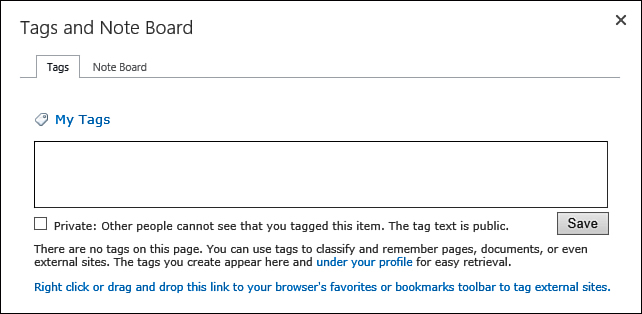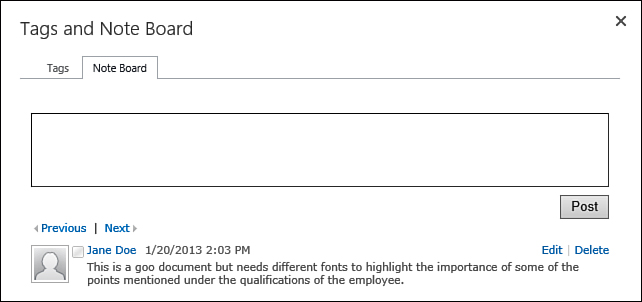1. Tag an External Site
Scenario/Problem:
You find a site that is useful. However, this site is not hosted in
SharePoint, and it’s not even part of your corporate site. You want to
be able to find it again using the tagging mechanism. For example, say
that you are tagging documents that are important for your day-to-day
work as “Useful for my project,” so that you can access them quickly
from one location in your personal site. You might also want to add an
Internet site to the list of useful items for the project.
Solution:
In SharePoint Server 2013, you can tag any link from any site, whether
it is hosted in SharePoint or not. To be able to tag external sites,
you need to open the tagging dialog by using the Tags & Notes
button on the Library or Files ribbons in a document library.
SharePoint opens the tagging dialog in page tagging mode, and it
provides a link that says “Right click or drag and drop this link to
your browser’s favorites or bookmarks toolbar to tag external sites,”
as shown in Figure 1.
You follow the instructions in the dialog to add the sites to your
browser’s favorites, and then you are ready to tag external sites.

FIGURE 1 The tagging dialog, when
opened from the Files ribbon for a file with no tags, shows the option
to add a special link to your browser’s favorites for tagging external
sites.
When you want to tag an external
site’s page with a tag, you browse to that page, open your browser’s
favorites, and click on the link you adde
2. View/Add Notes to a Document or List Item
Scenario/Problem:
You want to see whether any notes exist about a document or a list
item, and you want to add notes about a document or list item.
Solution:
In SharePoint Server 2013, you can add notes to a document. These notes
are available for other people to read. You can use this feature, for
example, to provide feedback on a document without actually changing
the document and without having to check out the document or even have
editing permissions to the document.
To add notes to a document, you select the
document in the web part or list view that displays the document to
switch to the Files ribbon. In the ribbon, you find and click the Tags
& Notes button to open the tagging dialog. In the dialog, you
select the Note Board tab. This tab allows you to type notes about the
document or view notes that other users wrote for that document, as
shown in Figure 2.

FIGURE 2 The Note Board tab of the tagging dialog. Existing notes are shown, with options to edit or delete them.